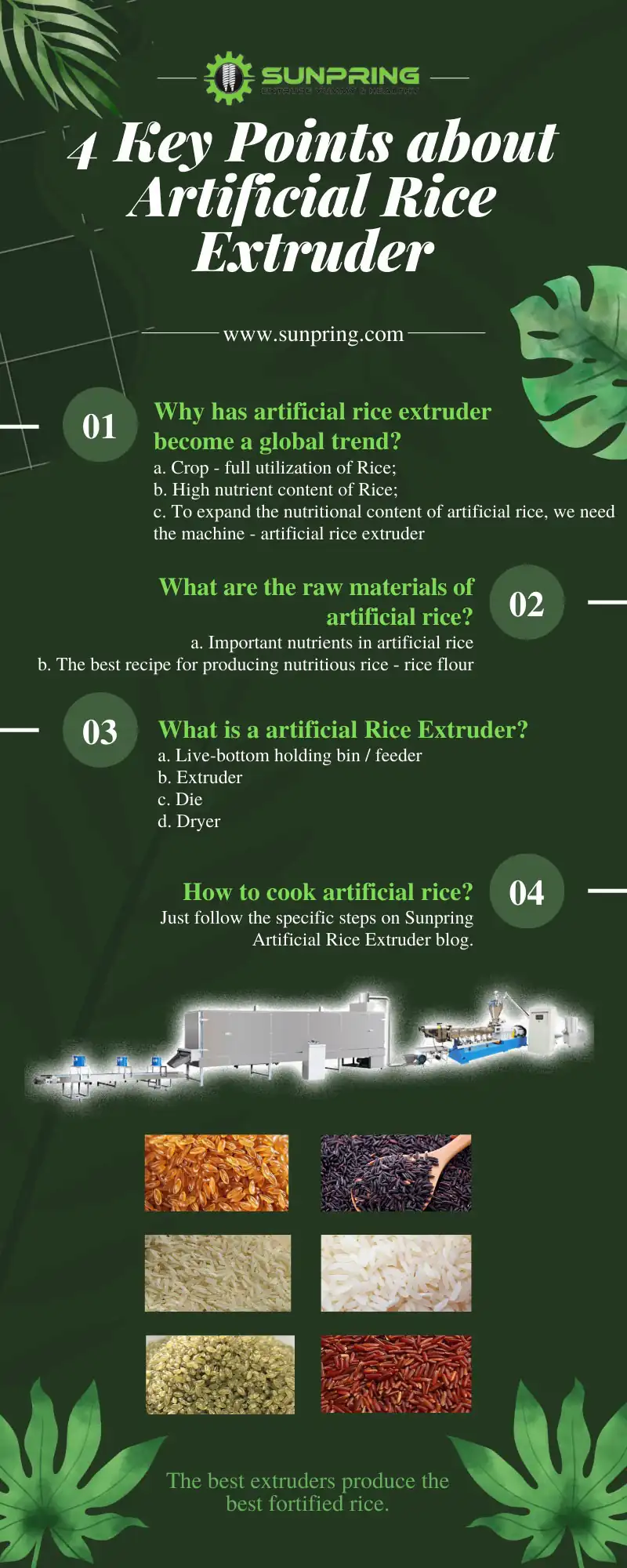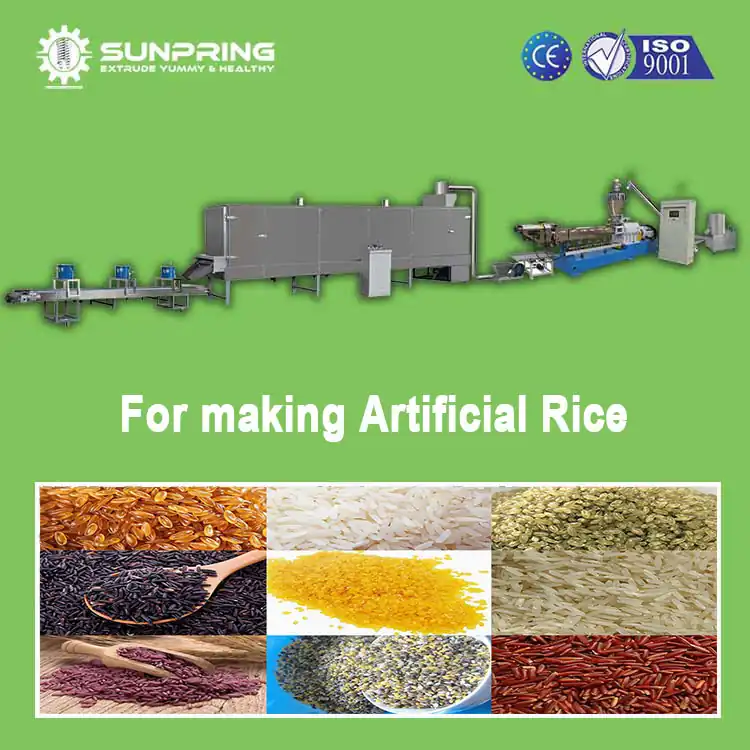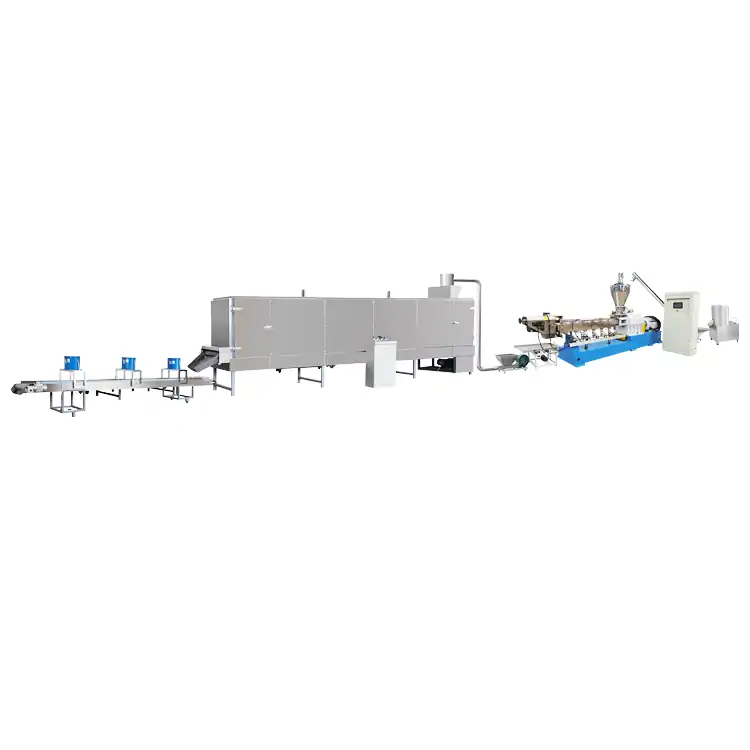 (Last Updated On: )
(Last Updated On: )4 Key Points about Artificial Rice Extruder
 Jinan Sunpring Extruder teach you how to start an artificial rice extruder businesss in 4 key points.
Jinan Sunpring Extruder teach you how to start an artificial rice extruder businesss in 4 key points.
Point 1: Why has artificial rice extruder become a global trend?
A. Crop – full utilization of Rice
Today, rice is one of the most important food crops in developing countries and it is considered staple food in many parts of the world. Rice is also becoming much more important in the United States, Europe, Asia and Middle East. However, concerns have been raised because it is high in starch and low in other essential nutrients. Another issue of concern is the breakage of rice kernels in the milling process, and these broken kernels are not generally accepted by consumers. Extrusion technology, which can be used to produce fortified rice, or rice analogues, can present a solution to both these problems, since desired nutrients / micronutrients can be incorporated in appropriate quantities in the rice mainly incorporating these nutrients in rice flour as the base material.
B. High nutrient content of Rice
Rice is one of the leading food crops and sustains two-third of the world’s population, providing 20 per cent of the world’s dietary energy supply. Despite being a primary food, rice is low in protein and high in starch. The low protein levels in rice cause deficiencies of protein and some essential amino acids in people who take it as their primary diet. For example, lysine, which is responsible for proper growth of the human body, is the essential amino acid found in the lowest quantity in rice.
Extruded rice has an advantage over real rice in that it can be flavoured and fortified with vitamins and minerals during extrusion. This could be especially important in parts of the world where nutrition is lacking.
C. To expand the nutritional content of artificial rice, we need the machine – artificial rice extruder
One approach to overcome these difficulties is to prepare rice analogues by extrusion, in which the vitamins are embedded and consequently do not separate from the rice grains. This will utilise mainly the broken rice which is either discarded or sold at lower prices. The fortification of rice analogues will allow consumers to benefit without making major changes in their dietary habits. Broken rice can also be ground into rice flour and used to produce value added products. Extrusion processing gives the option of reforming the rice flour into a precooked product that can be shaped, and have a texture similar to a cooked rice kernel. In this process, we can add different vitamins, minerals, beta-carotenes and other potential functional ingredients inside the rice body. The rice then can be sold to consumers who are looking for health benefits from eating foods. The rice does not need to be soaked in water for a long time prior to cooking, so therefore, all the added ingredients will stay within the rice.
Point 2: What are the raw materials of artificial rice?
A. Important nutrients in artificial rice
The raw materials used for the production of extruded rice are both the most expensive and the most important consideration of the process. There are several important raw material characteristics that require attention. These include the protein, starch, oil, fibre and particle size of each ingredient.
B. The best recipe for producing nutritious rice – rice flour
A wide variety of rice flours can be used as a base for the recipe. However, each flour imparts its own textural and flavour characteristics to the final product.
Point 3: What is the artificial Rice Extruder?
The extrusion portion of the system includes a live bin/feeder, extrusion cooker, and die / knife assembly. The design of each of these components is engineered to accomplish a specific function in the process of extruded rice. Within the design features, the operating conditions are adjusted to vary the properties of the finished product.
A. Live-bottom holding bin / feeder
The live bin/feeder provides a means of uniformly metering the raw materials (typically floury in nature) into the preconditioner and subsequently into the extruder. This flow of raw material must be uninterrupted and rate controllable. The live bin/feeder controls the product rate or throughput of the entire system. The live bin/feeder system can be controlled in a volumetric or gravimetric manner. In a volumetric setup, the feeder delivers a constant volume of feed to the preconditioner. When operating under gravimetric, or loss-inweight (LIW), conditions the feeder delivers a set mass flow rate of raw material to the preconditioner.
B. Extruder
Extruders used for the manufacture of extruded rice are twin screw in design. The impact on final product characteristics such as texture, rehydration, density, etc. is produced by screw and barrel profile, screw speed, processing conditions (temperature, moisture, retention time), raw material characteristics and die selection.
The initial section of the extruder barrel is designed to act as a feeding or metering zone to simply convey the preconditioned rice away from the inlet zone of the barrel and into the extruder. The material then enters a processing zone where the amorphous, free flowing rice flour is worked into a colloidal dough. The compression ratio of the screw profile is increased in this stage to assist in blending water or steam with the raw material. The temperature of the moist dough is increased slightly though the addition of mechanical energy via the extruder screws. The temperature rise in the extruder barrel is from mechanical energy dissipated through the rotating screw.
C. Die
The extrusion chamber must be capped with a die apparatus. The die offers restriction to product flow and shapes the extrudate. Dies for extruded rice are typically face dies. The die is fitted with a variable speed cutting device to size the kernel.
D. Dryer
The extrusion chamber must be capped with a die apparatus. The die offers restriction to product flow and shapes the extrudate. Dies for extruded rice are typically face dies. The die is fitted with a variable speed cutting device to size the kernel.
Point 4: How to cook artificial rice?
The texture of the prepared rice will be affected by the preparation procedure. The preparation methods are typically very flexible. The rice simply requires rehydration to 58 to 60 per cent moisture, in order to be edible. The following procedures have shown to give good results:
A. Add equal volumes of rice and cold water to a container. Then cover and allow to set for two hours for complete rehydration.
B. Put equal volumes of rice and water in a microwave safe container. Microwave on high until the water begins to boil. Cover the container and wait for 10 minutes for complete rehydration.
C. Boil the rice for three to five minutes in excess water. The water should be boiling before the rice is added. Then remove the heat and allow to set for an additional six to eight minutes before draining off the excess water (the entire time needs to be 10 to 12 minutes)
D. One part rice can be added to 1.25 parts boiling water (by volume). The rice should be boiled for three minutes, then covered and allowed to sit for an additional seven to 10 minutes.
In order to achieve the above conditions, we recommend the following 8 fish feed formulas.
The final rice texture can be adjusted by using modifying the ratio of water and rice and altering the rehydration times. For example using additional water and longer rehydration times will result in the rice having a softer texture.
Write to you in front of the screen:
If you want to get more business tips about artificial rice extruder, please feel free to contact us, we will provide you with comprehensive solutions from raw materials to production.



Need sunpring frk machine ….
Pls share type of machine and there details along with price for India. Fortified rice kernal making machine.
I Sri Sai Krishna modern rice mill need to frk machine
My friend, thanks for your inquiry!
Emma has sent more info to your email, please check it!